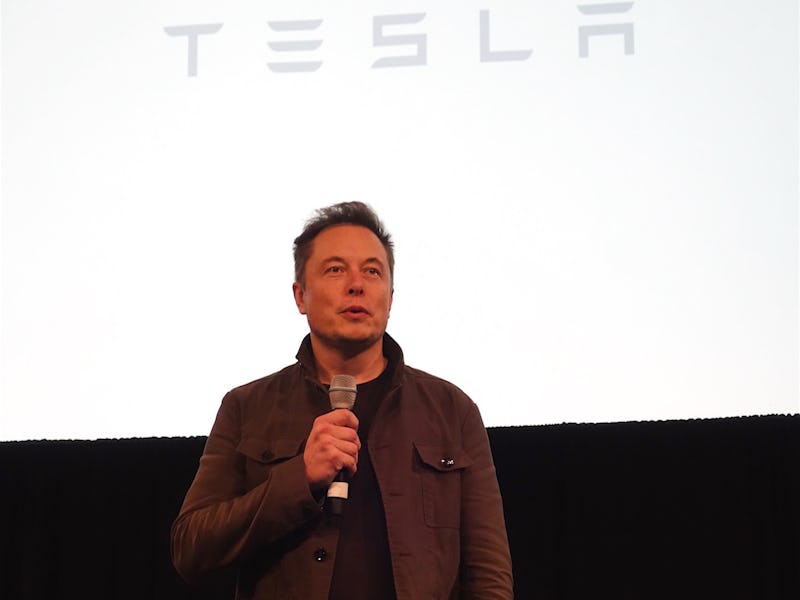When Will Elon Musk Announce Autopilot 2.0 and the Model 3 HUD?
Batteries are cool, but these pending announcements would be way cooler.

On Tuesday, Elon Musk announced the Tesla P100D: a 100 kWh electric car battery. A Tesla Model S equipped with the P100D goes zero to 60 mph in just 2.5 seconds, making it the quickest car in production in the world. It’s faster than Bugattis, McLarens, and Lamborghinis. On top of all that, it’ll now take you 315 miles on a single charge. This is great news for those with deep pockets, but it’s not what everyone was hoping Musk would announce.
Many were expecting that the Tesla founder and CEO would announce Autopilot 2.0, which — when it is announced — will get us one step closer to fully autonomous cars. The update would include more sensors and cameras, along with a major software update, making the artificial intelligence system more adept at understanding its surroundings — which, in turn, will make human drivers all the more obsolete.
The Tesla Model S.
In a conference call with the media before the big battery news, Musk didn’t answer any reporter’s questions about an updated version of Tesla’s popular but controversial driver-assist technology. Electrek’s Fred Lambert reported this quote from Musk: “One thing I should say though is that with version 8 of the software, which is hopefully going to final review right now, there will be material improvements in the autonomy of the car. I think the amount of work that has been going into version 8.0 will be very noticeable.”
So the latest version of the software is in final review and “there will be material improvements” to its autonomy. It seems like a new version of Autopilot is coming soon.
In an early-August investor call, Musk promised that the next generation would “blow people’s minds,” but elected not to elaborate. The current version of Autopilot is already safer than most if not all humans, and it’s only in beta. But “beta,” for Autopilot, just means that it’s yet to tally its billionth mile. After crossing that threshold, it will graduate from its beta status, for which it’s received some undue criticism. With this update, though, Tesla would silence critics: An already exceptional self-driving system becomes fully autonomous, and acquires even more data it can use to improve.
Since Autopilot is an A.I. system, it’s able to learn with each mile driven. These miles can be driven in real life or simulated. When something bad happens in either scenario, the A.I. can play it back, evaluate alternative reactions and their potential outcomes, and record the appropriate response in case a similar situation crops up in the future. It’s able to do so by virtue of its hardware — various sensors and cameras — and, more importantly, its software — the A.I.
Musk told investors earlier this month that full autonomy is “really a software limitation: The hardware exists to create full autonomy, so it’s really about developing advanced, narrow AI for the car to operate on. Increasingly sophisticated neural nets that can operate in reasonably sized computers in the car, that’s our focus. I’m very optimistic about this.”
Unfortunately, it seems that the software is not yet up to task, and so we were not privileged with this announcement. Yet.
The Tesla Model 3.
The other big announcement that people hoped for was the second half of the Model 3 unveil.
Back in March, Musk unveiled the Model 3. We learned many things about the car, including that it would feature a redesigned 15-inch landscape display. The Model 3’s most noticeable oddity was its bland dashboard, which lacked an instrument panel. Gone were the familiar speedometers, odometers, and other such -meters; in their place was, well, nothing.
Needless to say, these are important instruments, vital for safe driving, and a regulatory authority would likely not approve if they were nonexistent. Though the display could present this information, it wouldn’t be as visible as regulators would like. Many began to speculate, then, that an HUD would make up for this absence. The case was strong.
The Model 3's interior, as shown during its unveiling.
And the case grew stronger yet with Musk’s flirtatious tweets. March’s event, he wrote, was “Part 1 of the Model 3 unveil. Part 2, which takes things to another level, will be closer to production.” (We’re just about a year out from the forecasted production start-date, and Model 3s will begin to ship toward the end of next year.) Later, he responded to a random tweeter who gave his unsolicited input: “Wait until you see the real steering controls and system for the 3. It feels like a spaceship.”
If the Tesla Model 3, the electric car manufacturer’s consumer option, featured a heads-up display, demand would skyrocket once more. Most major car companies have models with HUDs, but a Tesla HUD — simply because it’s Tesla — would blow these competitors out of the water. But Musk would then need to reckon with an increased production burden: Again and again, he’s promised to deliver Model 3s on schedule, but already faces about 400,000 reservations. With an added HUD and such a (relatively) low price tag, even us broke bloggers would consider the investment.
The spaceship cometh. Just not quite yet.